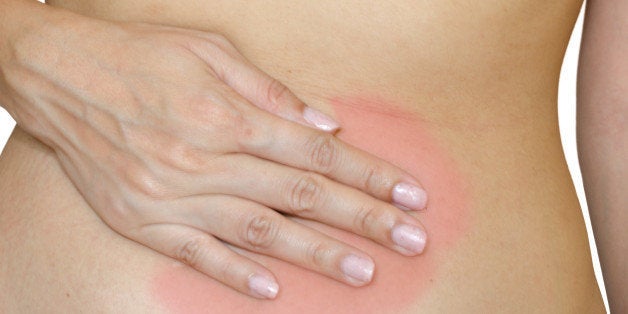
By Christine Yu
Chances are, you've experienced the agonizing telltale symptoms of a urinary tact infection (UTI): the constant need to pee, and the awful burning sensation every time you go. UTIs are one of the most common types of infections, resulting in more than 8 million doctors visits each year.
"UTIs are most often caused when bacteria gets into the urethra," which is the tube that allows urine to pass out of the body, explains Daniela Carusi, MD, assistant professor of obstetrics and gynecology at Brigham and Women's Hospital in Boston. They can occur in any part of the urinary tract -- kidneys, ureters, bladder or urethra. Most of the time, your body flushes out the bacteria with your pee, no problem. But sometimes, the bacteria stick around, and grow. While most women will notice it when it hurts to pee, some may just feel a dull pelvic ache or even develop a fever.
Whether it's your first UTI or you've had one multiple times, we've got the facts on what you need to know to deal with this common problem.
See your doctor
If you're feeling the burn, don't wait around. You need to see a doctor, stat to prevent the infection from spreading to other parts of the urinary tract like the kidneys. While there are over-the-counter remedies to help you feel better (more on those later), only antibiotics can cure an active infection.
Your doc can take a urine sample and do a rapid, in-office test for infection. Sometimes other down-there problems like yeast infections can mimic the symptoms of a UTI, so she'll want to know exactly what's going on. If the test is positive, she can prescribe the correct antibiotic.
While all UTIs require prompt treatment, this is particularly important if you're pregnant. "If you don't treat it, even in the early phases, it can cause early labor," Dr. Carusi says.
Pain relief is within reach
The good news: Once the antibiotics kick in, you'll start feeling much better. The bad news: It might take a day or two. How can you find relief if you're in crazy pain while waiting for a doctor's appointment or the antibiotics to work their magic?
The best thing you can do is drink lots of water. Yes, this will make you pee more, but frequent bathroom trips will help move the bacteria out of your system. Plus, the extra water will dilute your urine, taking away some of the sting. "Keeping the bladder flushed can help with the pain while waiting for treatment," says Dr. Carusi.
Over-the-counter medication like AZO, which acts like an antiseptic for your bladder, can also diminish your discomfort. Pain relievers like ibrporfen can help ease your aches and any flu-like symptoms.
RELATED: 27 Mistakes Healthy People Make
You can get a UTI again...and again
Sad, but true: Your first UTI is likely not your last. "Recurrent UTI is fairly common," explains Jennifer Ashton, MD, an obstetrician-gynecologist and co-host of The Doctors.
They come back for a number of reasons. A common one: not finishing your antibiotics can allow lingering bacteria to multiply and re-start the infection, so be sure to finish the entire prescribed course, even after you start feeling better.
Also, simply being female puts you at risk for repeat infections because women have shorter urethras compared to men, which makes it easier for bacteria to get in to the tract and reach the bladder, Dr. Carusi says.
Sex causes it, too
No, UTIs aren't a sexually transmitted disease, but the physical act of sex can bring them on. "Since the urethra sits right next to the vagina, bacteria in the vagina can move around and get into the urethra and the bladder," Dr. Carusi says.
To help lower your risk of infection, pee right before and after your next romp in bed to flush the urethra of bacteria. An extra step you can take if you're already doing that: pee, then clean the area around the vagina and rectum with a wet wipe.
It may also be your birth control
Spermicide, condoms, and diaphragms are all good forms of birth control. The downside? They may also irritate the skin around your vagina and urethra, making it easier for bacteria to invade, Dr. Carusi says. Diaphrams can also decrease the flow of urine so it's harder to empty the bladder fully, which creates a ripe environment for bacteria to multiply.
If you're experiencing re-current infections, and peeing after sex isn't helping, you might consider discussing other types of birth control with your doctor. It may be as simple as switching condom brands.
Cranberry juice really might help
We've all heard the old wives tale about cranberry juice being great for your bladder. While a helping of cranberry can't treat an infection, drinking cranberry juice in addition to staying hydrated generally might be helpful for supporting the health of your urinary tract.
"The theory is that [cranberry juice] interferes with the bacterial ability to adhere to the bladder wall," Dr. Ashton says.
It's not just a young woman's issue.
While sexually active young women are very prone to UTIs, that doesn't mean older women aren't at-risk too. As hormone levels drop during menopause, your skin gets more fragile...even down there. "The skin in the vagina and urethra changes quite a bit," says Dr. Carusi. "It gets thinner and can be more susceptible to infections."
Fortunately, applying a topical estrogen cream, available by prescription from your doctor, often helps. Bonus: these creams can help with vaginal lubrication and relieve symptoms of vaginal irritation that can be a problem during menopause, too.
More from Health.com
Your Urinary Tract: A User's Manual
10 Foods to Avoid If You Have Overactive Bladder
Am I Normal 'Down There'?
7 Things Every Woman Should Know About UTIs originally appeared on Health.com
Also on HuffPost:
